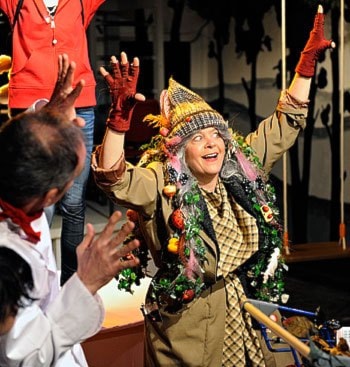The second act of Into the Woods begins with fairy tale icons contemplating whether they should have wished for what they got.
At about the same time, the Guild’s audience is contemplating whether they should have ducked out at intermission.
To say the production is long is an understatement.
But what better than a world of fantasy to whisk audience members away, without noticing how much time has passed?
Unfortunately, with Into the Woods time remains very real.
The opening act is 90 minutes, and all it really does is establish the stories we already know.
Cinderella gets to the ball, loses her shoe, the prince uses it to find her and they live happily ever after.
Jack sells the cow for beans, the beanstalk grows, he kills the giant, gets rich and lives happily ever after with his poor old ma.
Little red riding hood finds her sick granny in the stomach of the big bad wolf, but is cut out to learn her lesson and lives happily ever after.
The main difference with Into the Woods is that a baker and his wife, who have been cursed sterile, tie all the stories together. They need to snatch a piece of each narrative to reverse the curse.
While the second act provides the opportunity for all those critical thinkers out there to see if the prince really is perfect, if Jack and his mom can really handle living a life of luxury and if the barren bakers can actually handle the little rug-rat, the additional hour really drags on.
It dragged on in the original, Tony award-winning Broadway run in the late 1980s as well.
But all in all, the Guild simply took on a play that was too big. It proved more than the company could handle.
Most noticeably, the space was much too small.
They get full marks for trying - much of the first act is constructed like three separate stages in one. But the cramped conditions simply added to the confusion of it all.
And while the live band sounded great and didn’t miss a single beat of the difficult score, they were louder than the actors.
With its quick rhymes and wide range, Stephen Sondheim’s original music is tough for any group of actors. The sound is classic musical, with rhyming tunes that get stuck in your head for the next week. And the modern, witty script nicely compliments the tunes.
But most of the actors had weak voices that couldn’t compete with the instruments. The size of the room was just too small.
In the Guild’s production, director Gerald Isaac staged the play in a modern schoolyard and changed the disconnected narrator into a young girl who interacts with some of the characters.
It does seem more fitting and playful to have a young girl tell the story from within a playground, but the idea came across as underdeveloped.
Sarah Ott, the young girl who played the narrator, held her own and never broke character, but her role in the narrative was inconsistent and confusing.
As well, there was no explanation or context given to the playground equipment. The teeter-totter, slide and carousel were well used, but apart from providing diverse ground for the characters to cover, they only served to trivialize the content.
However, Isaac’s few tricks to modernize the play were both witty and well received.
Most notably, both Cinderella and Rapunzel’s princes, donning leather jackets, sang their devotion to cellphone photos of their damsels, to much laughter from the audience.
And it was Cinderella’s prince that truly stole the show.
Winluck Wong was one of three actors who played more than one role.
His portrayal of a sexually suggestive wolf in the first act was simply hilarious and made up for his singing voice, which sounded untrained and feeble.
The wolf’s innuendos seemed to be satisfied in the second act when Wong, as the prince, had an affair with one of the other characters.
“I was raised to be charming, not sincere,” he said, extinguishing his post-coital smoke.
So while Bernadette Peters’ witch in the ‘80s Broadway production was the obvious star, Wong’s performance overshadowed Bronwyn Jones, who played the witch in this version.
The baker and his wife also hold integral roles and while both James McCullough and Shauna Jones held their own vocally, their chemistry seemed forced and insincere.
During the first act, Jones catches up to her husband on roller skates and, while her maneuvering was impressive, it only added more confusion as the skates were never explained or seen again.
The only voice that really could be heard over the music was little red riding hood, played by Erica Bigland. And while her humorous antics were appreciated, they were diminished by the exaggerated high-pitched, shrill voice.
Cinderella’s step family, Jack and his mom and Rapunzel were all believable, but their quiet voices kept them in the fifth business.
Bruce Barrett, who played the cleverly named “mysterious man,” was a confusing addition to the Broadway version and only provided the same at the Guild.
Rebecca Whitcher played Cinderella. Her timidity, furrowed brow, quiet voice and slight figure fit her character well. Unfortunately, her voice was also drowned out by the music.
All actors showed admirable devotion and effort, but it’s not rewarded by this marathon of a play.
And with its overpowering sound, too much attention goes to the band.
Made up of flute, piano, violin and percussion, it performed well.
But conductor Brad L’Ecuyer’s directing hand and page turning were both noticeable and distracting.
And when the play approached its end, the most telling reaction was that of violinist Kieran Poile.
From the musician’s perch he looked down at the actors. His head, resting in his hand, was slouched against the neck of his violin.
His downturned face was one of obvious boredom.
Into the Woods is at the Guild until April 30, running Wednesdays through Saturdays.
Contact Roxanne Stasyszyn at
roxannes@yukon-news.com
